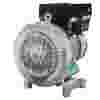Introduction
In industrial operations, vacuum and compressed air systems are both essential, but they serve very different purposes. While compressed air delivers short, forceful bursts of energy, vacuum systems are designed for steady, controlled flow. Comparing the two without context can lead to inefficient choices, higher energy costs, and unnecessary maintenance.
This article explores how each technology works, where it performs best, and how to make informed decisions based on your specific application, whether you're conveying powders, gripping components, or drying surfaces.
Understanding the Fundamentals
Compressed air systems work by storing energy as pressure, typically between 6–8 bar and releasing it in short bursts. They're commonly used for actuation, blowoff, and cleaning. Vacuum systems, on the other hand, create sub-atmospheric pressure to draw air or material toward the pump. This makes them ideal for continuous flow tasks like gripping, leak testing, and conveying.
The key difference lies in how each system delivers energy. Compressed air is forceful and intermittent. Vacuum is gentle and continuous. That’s why the right choice depends entirely on the job at hand.







